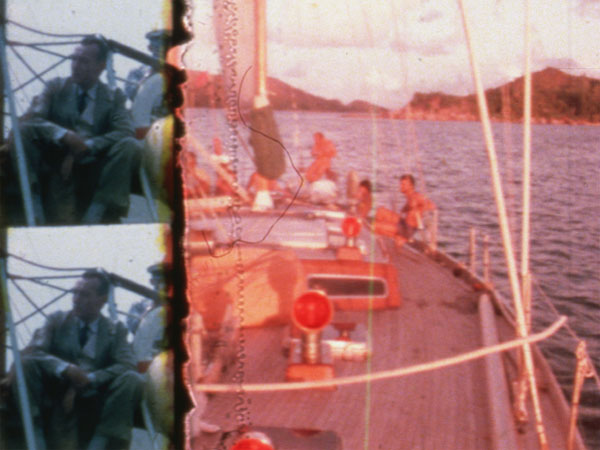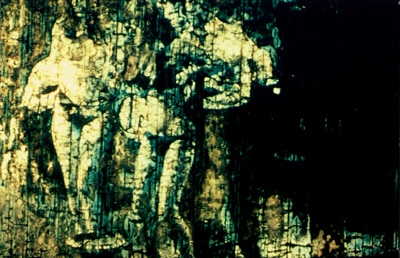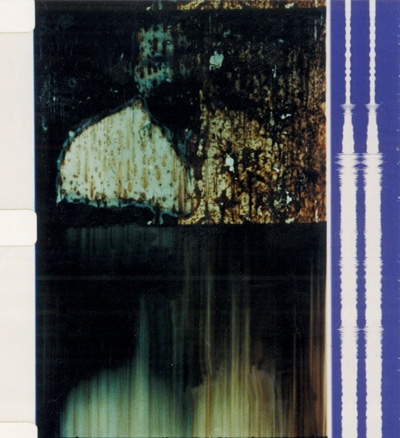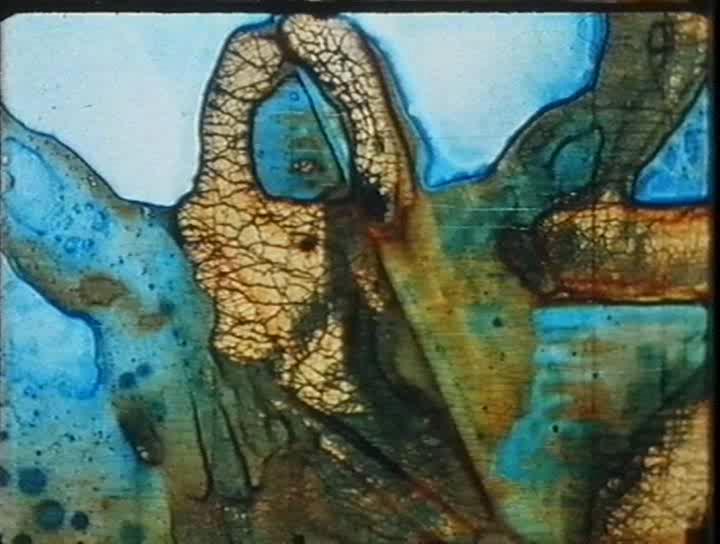
Strange Developments in Ecstacy: an interview with Jochen Lempert from Schmelzdahin
Schemzdahin is a super-8 filmmaking collective made up of Jochen Lempert, Jurgen Reble and Jochen Muller. From their beginnings in 1975 they have signed all their work only with their group name: Schmelzdahin, which means “melt away.” They describe themselves this way: “For instance, we are inside a centrifuge in a submarine. Fortunately, we have forgotten the expedition’s task. The navigation is carried out by emotions, waves and heavy eruptic thinking.” This self-description extracts the three patterns of their unique and radical approach to imagery. Their experiments are emotional, their mages create a synthesis of film and nature codes, and their stories are situated somewhere between the swarming brain of Grman expressionist author Gottfried Benn and Stan Brakhage’s closed-eye visions. Basic to their work are the various image-creating methods they employ. Schemlzdahin has developed different techniques to destroy, crumble or literally melt away images. Film stock is treated with acid, coloured and sketched. Their own shootings or found footage is submerged until algae have grown into the emulsion, films have been wrapped around plants to absorb their moisture or buried until colour and grain are eaten by bacteria. The film-harvest is then dried, cleaned and copied on a machine of their own invention.
This interview came at a difficult time; problems within the group has led to a (temporary) break-up. How temporary is anyone’s guess, the future seems uncertain.
JL: Twelve years ago we began working as a group, three people called Schmelzdahin. We are at a critical moment now because one of us has moved, so I don’t know whether it’s going to continue. We’ve never made films under our own names, only as a group for twelve years now. We met in school when I was sixteen, Jurgen was eighteen.
MH: So instead of starting a rock band you wanted to make films?
JL: We did a lot of things: theatre plays and performances, always playing games, then sometimes for the public. Later we used filmmaking as a catalyst for getting into ecstasy. For the first years in Bonn the films were just funny. We had our own cameras.
MH: Did you start making films because you saw films that inspired you?
JL: It came more out of television. Quite early we were interested in experimental films. We had different moments in our development. The first films had a lost of costumes, ecstasy, and then there was a small period where the other were making larger films also on super-8, funny and dramatic but these weren’t important. They were like the earlier films but longer. I 1981 we didn’t do much, then we started again in 1982-3, and we worked continuously from then on. We had a small garden in the house where we lived.
MH: You lived together as well?
JL: In a way. Paul lived in a van and I lived in the same town and I would stay in Jurgen’s place for some weeks. We just worked every day for months. We really got into it.
MH: Almost all experimental filmmakers work alone. How do you work as a group?
JL: Usually we don’t work with three but with two because with three it’s not so productive. When two edit, one stands and looks while the other cuts.
MH: So there’s a lot of discussion?
JL: Yes, but not much argument because we like the same things.
MH: Did you argue more at the beginning?
JL: No, more at the end. We don’t have any ideas in advance, we start playing. In the last years we started up a large collection of films, an archive. It comes from dead grandfathers, flea markets or films simply found somewhere. We shot ourselves without purpose, everyone shoots. There were periods when we felt like shooting so we would shoot together. So we have this collection of material and we start to work with it, look at it a hundred times and cut pieces together. Then we treat the film and watch it over and over, and if it gets boring we throw it away. You can only judge the final image when you see it many times. In the last film we made – at the moment it’s called XXX, maybe out last film – it developed in a different way. It’s mainly based on the development, its chemistry. Two of us had fever for two weeks during the time we made this film. One night we had this strange development where we got a red-green shimmering. It’s a very psychedelic film to imagine, a fairy tale. Some of the film came from images we had in our archive for a long time already. For example, there’s some material that Paul shot with children on the road with his van, a fairy tale film he shot but never used. With this strange development that happened one night, we were completely (untranslatable word). We got into it, and we had one cassette, Gilbert and Lewis, that we played all the time over these two weeks, always making the development to this rhythm. At night we dreamt in the same colours. This film is just a state of mind now, and we didn’t continue to work on it. We left it like that, so it’s a documentary in a way. But we don’t have anything we want to show in the film, the film shows it to us.
MH: And you don’t have a problem working in such a close collaboration?
JL: At the moment we have a problem. I’m talking about the past. At the moment we all live in different towns.
MH: Are you always through this archive of films?
JL: Yes, when there’s not one film you work on all the time, you take one reel and make a cut here and a cut there. Somehow they get together on one reel and on this reel we work on it. At a certain point this material looks like a film and then there’s intensive work for several months and we see it many times and we show it in public and make changes.
MH: Do you talk to people at your shows about what’s working and what’s not?
JL: We know by the feeling when we watch it. At one point it’s finished, when it’s not interesting any more. All the films are very different. Krepl is ten minutes long, colour, 1989. We used material I shot in Africa in a small village in Liberia, an American colony. Some images were taken at the lab where I worked as a biologist, genetic research. One stormy night we cut up this mouse at our lab, the cat brought in this pregnant mouse and we just opened it. The last shot of the film.
MH: There’s a lot of hand processing in the film. Was that the footage you shot in Africa?
JL: This was a copy from the original stock with an optical printer we built ourselves from a projector. It’s necessary if you get into these chemical things, you have a huge amount of waste materials.
MH: Why did you start with the chemicals and hand-processing? Do many work this way in Germany?
JL: Maybe now there are more. We did everything ourselves, and this is the only thing we didn’t do ourselves. At one point I had the feeling we were just going backwards from an industrial film to handcraft. We also tried to make an emulsion. The feeling we have for film comes from its chemistry, and our fascination with alchemy.
MH: Do you keep logs or books about the effects of your chemical work?
JL: We found it out all ourselves, like an experimental film. We are on a scientific expedition with occasional intense thinking and feeling and accidents. It’s a wave… I don’t know the English word, it means coincidence. These are the means of our expeditions.
MH: But the work also seems quite political. In Stadt im Flammen you’ve taken a super-8 condensation of the French-Canadian film Ville en Flame, burned away its dramatic surface, destroyed the habits of theatre in order to get back to the film’s base, to start over where something else is possible. Stadt im Flammen engages quite directly in the politics of image making.
JL: Of course there are a lot of these things but they’re not on purpose. We live with the films as we live with each other so it doesn’t have so many purposes. Everything gets into it. You don’t have to think about it, like making breakfast.
MH: Can you describe your performance work?
JL: When we did our European tour last year we started with a performance which shows a loop, the room is dark and we have candlelight on and everyone comes in the front and we have a loop of say, Nosferatu, and then we start to treat the material with chemicals, so each time it goes through the projector it changes until it’s finished, until it’s the best possible. Yesterday we made an installation, it’s not in the official program, we just put it up close to the toilet. It’s a double projection, a complete destruction machine. It doesn’t destroy itself, it destroys the film. The film runs from the projector into a kitchen blender and gets blown to dust and then the dust is projected. You see the image only once.
MH: Is there a big film scene in Bonn?
JL: No, so it’s very good to work in Bonn. You can concentrate, just go on to work on your films in the night.
MH: Do you all work?
JL: We all did different things. I used to study. Paul worked occasionally as a set decorator for theatre.
MH: How do you eat?
JL: Yes, that’s not easy. It’s not clear for me at the moment. The last years we got some grants for some films which was enough to live on for a little while. At the moment it’s not too clear how it can continue. There are quite a few places in Germany to show film.
MH: So you’ve been able to show your work widely…
JL: That’s not a problem.
MH: Do you always go with your films?
JL: Usually we want to, the whole thing is to make it an event, not just to show films.
MH: You have all your films at home, at your own lab?
JL: Yes.
MH: Do you see a lot of other people’s work?
JL: In the last years, yes. At the beginning not very much. If you’re showing your films more you have more opportunities. It was never very important for our work because it came so much out of own circumstances.
MH: Did your wanting to study biology come out of your filmmaking?
JL: No, I was on a preservation island where I did my civil service for two years on the North Sea. IT was a very good time, and I started to study biology on my own. If you’re to going to the army you go to the civil service. If you’re lucky you get a job like this.
MH: In a year how much film would you make?
JL: We’re working on material all the time, there’s different stages of work. There’s continuous work, and then if there’s something that’s the real film we work on that and use the others just for relaxing. (laughs) In a year we finish maybe two-three films, which are only between six and fifteen minutes. It’s not very much. It’s hard to tell because we sometimes show films at different stages of completion. All of our work is super-8. Super-8 is strong in Germany because some people have been working with this for years and are now making interesting films, and they can do this without CVs or money. They make their own films and this is always difficult if you need money. It’s a long process to start working and you’re more concerned with the result and this is not very helpful. There’s also people working in 16mm.
MH: You’re 31 years old. Across the country there are a generation of folks roughly your age who have made their early films, understand something of the history, and are continuing to make their own work.
JL: Yes, like Alte Kinder or Michael Brynntrup, Michael Krause, Anarchist’s Rubber Cell, Uli Sapok…
MH: Are there are other groups who work in super-8?
JL: Yes, at least they have a group name. If you have only technical relationships this doesn’t lead to group relationships. Maybe that’s why it can happen with super-8. You don’t have to concentrate on equipment or money or technique, only on your group feeling. (laughs) But there are only a few groups.
Schmelzdahin Films
1975-78
Scholli’s Truhe 10 minutes; Cutaway (8 minutes); Die golden Sechsziigerr (19 minutes)
1979
Was bin ich (15 minutes)
1983
Augentruffel (5 minutes); Munzesheim (6 minutes); Sparlich gelungener Wurf mit boseum Loffel (3 minutes);p Dere Meister (3 minutes); 50’45N 7*9’E (4 minutes); English for today (3 minutes); Dallas (5 minutes); Bilderserie (10 minutes); Such nachverlorenen Selen (6 minutes)
1984
Rudi Dorfert (15 minutes); In diep Hust (6 minutes); Stadt im Flammen (6 minutes); Pelshing (1.7 minutes); Die Lange Nacht der Kaisserpinguine (4 minutes); Weltenemfanger (8 minutes)
1985
Feuerland is abgebrannt (6 minutes) Trompetentierchen (13 minutes); Der Mieter (3 minutes); Knochel (diverse lengths)
1986
Mauser (134 minutes) Onkelschrompel (7 miutes); E.R. (6 minutes); Situs we jod, issed ab sernit (6 minutes0; Eis (7 minutes) Aus denAlgen (10 minutes0; Der Emfindliche (5 miutes); Der Rebell (diverse lengths)
1987
Hab ich Gesehen, der General (15 minutes)
1988
Weisspfennig (6 minutes); Krepl (8 minutes); Schildmayer Darlaten (12 minutes)
1989
Rumpelstilzchen (12 minutes); XXX (19 minutes)
(Originally published in The Independent Eye Vol. 11 No. 2/3 Spring 1990)




